MGNT910 Assessment 4: Strategic Analysis of University of Wollongong
VerifiedAdded on 2023/01/20
|30
|6320
|66
Report
AI Summary
This report presents a comprehensive strategic analysis of the University of Wollongong (UOW), fulfilling the requirements of a take-home exam for the MGNT910 course. The analysis begins with an introduction and a background of UOW, followed by an internal analysis, identifying its strengths and weaknesses. The external environment is examined using PESTLE and Porter's six forces analyses to identify opportunities and threats. A SWOT analysis synthesizes the internal and external assessments, leading to the identification of business, corporate, and functional level strategies. The report also explores UOW's organizational strategy and provides a financial analysis, including ROIC, ROA, and current ratio calculations, along with strategic recommendations. Appendices include supporting data and figures. The report concludes with a summary of the findings and a list of references.
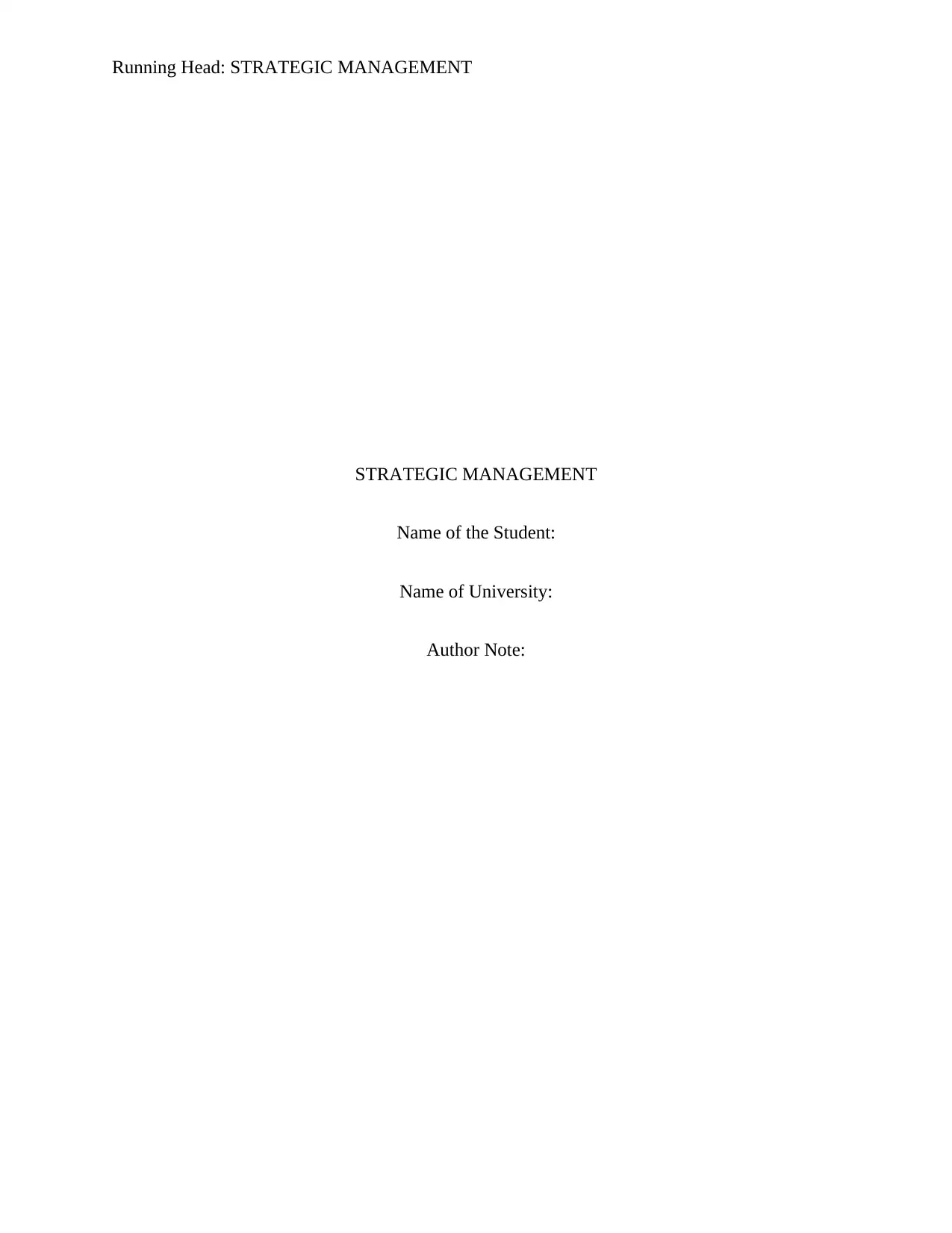
Running Head: STRATEGIC MANAGEMENT
STRATEGIC MANAGEMENT
Name of the Student:
Name of University:
Author Note:
STRATEGIC MANAGEMENT
Name of the Student:
Name of University:
Author Note:
Paraphrase This Document
Need a fresh take? Get an instant paraphrase of this document with our AI Paraphraser
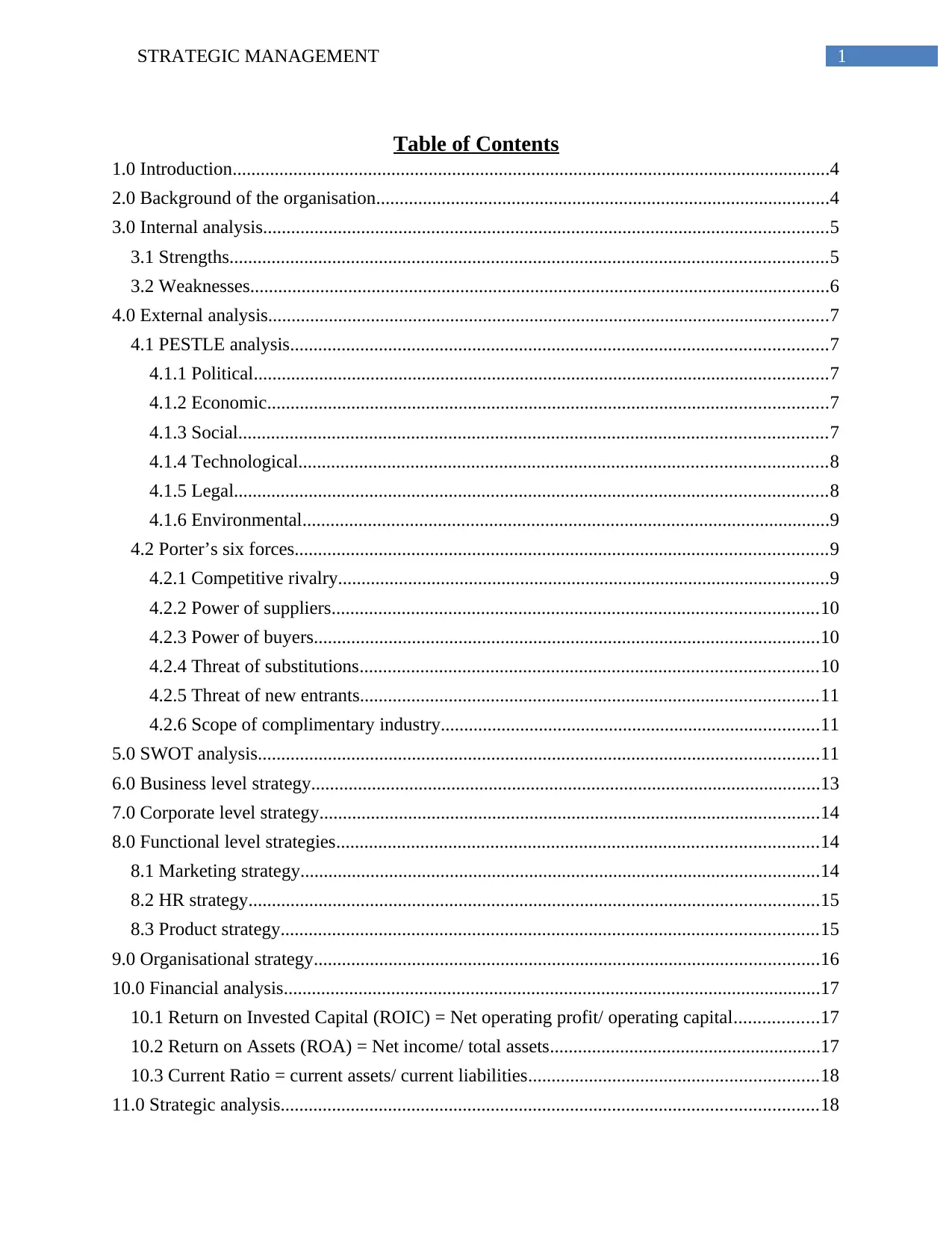
1STRATEGIC MANAGEMENT
Table of Contents
1.0 Introduction................................................................................................................................4
2.0 Background of the organisation.................................................................................................4
3.0 Internal analysis.........................................................................................................................5
3.1 Strengths................................................................................................................................5
3.2 Weaknesses............................................................................................................................6
4.0 External analysis........................................................................................................................7
4.1 PESTLE analysis...................................................................................................................7
4.1.1 Political...........................................................................................................................7
4.1.2 Economic........................................................................................................................7
4.1.3 Social..............................................................................................................................7
4.1.4 Technological.................................................................................................................8
4.1.5 Legal...............................................................................................................................8
4.1.6 Environmental.................................................................................................................9
4.2 Porter’s six forces..................................................................................................................9
4.2.1 Competitive rivalry.........................................................................................................9
4.2.2 Power of suppliers........................................................................................................10
4.2.3 Power of buyers............................................................................................................10
4.2.4 Threat of substitutions..................................................................................................10
4.2.5 Threat of new entrants..................................................................................................11
4.2.6 Scope of complimentary industry.................................................................................11
5.0 SWOT analysis........................................................................................................................11
6.0 Business level strategy.............................................................................................................13
7.0 Corporate level strategy...........................................................................................................14
8.0 Functional level strategies.......................................................................................................14
8.1 Marketing strategy...............................................................................................................14
8.2 HR strategy..........................................................................................................................15
8.3 Product strategy...................................................................................................................15
9.0 Organisational strategy............................................................................................................16
10.0 Financial analysis...................................................................................................................17
10.1 Return on Invested Capital (ROIC) = Net operating profit/ operating capital..................17
10.2 Return on Assets (ROA) = Net income/ total assets..........................................................17
10.3 Current Ratio = current assets/ current liabilities..............................................................18
11.0 Strategic analysis...................................................................................................................18
Table of Contents
1.0 Introduction................................................................................................................................4
2.0 Background of the organisation.................................................................................................4
3.0 Internal analysis.........................................................................................................................5
3.1 Strengths................................................................................................................................5
3.2 Weaknesses............................................................................................................................6
4.0 External analysis........................................................................................................................7
4.1 PESTLE analysis...................................................................................................................7
4.1.1 Political...........................................................................................................................7
4.1.2 Economic........................................................................................................................7
4.1.3 Social..............................................................................................................................7
4.1.4 Technological.................................................................................................................8
4.1.5 Legal...............................................................................................................................8
4.1.6 Environmental.................................................................................................................9
4.2 Porter’s six forces..................................................................................................................9
4.2.1 Competitive rivalry.........................................................................................................9
4.2.2 Power of suppliers........................................................................................................10
4.2.3 Power of buyers............................................................................................................10
4.2.4 Threat of substitutions..................................................................................................10
4.2.5 Threat of new entrants..................................................................................................11
4.2.6 Scope of complimentary industry.................................................................................11
5.0 SWOT analysis........................................................................................................................11
6.0 Business level strategy.............................................................................................................13
7.0 Corporate level strategy...........................................................................................................14
8.0 Functional level strategies.......................................................................................................14
8.1 Marketing strategy...............................................................................................................14
8.2 HR strategy..........................................................................................................................15
8.3 Product strategy...................................................................................................................15
9.0 Organisational strategy............................................................................................................16
10.0 Financial analysis...................................................................................................................17
10.1 Return on Invested Capital (ROIC) = Net operating profit/ operating capital..................17
10.2 Return on Assets (ROA) = Net income/ total assets..........................................................17
10.3 Current Ratio = current assets/ current liabilities..............................................................18
11.0 Strategic analysis...................................................................................................................18
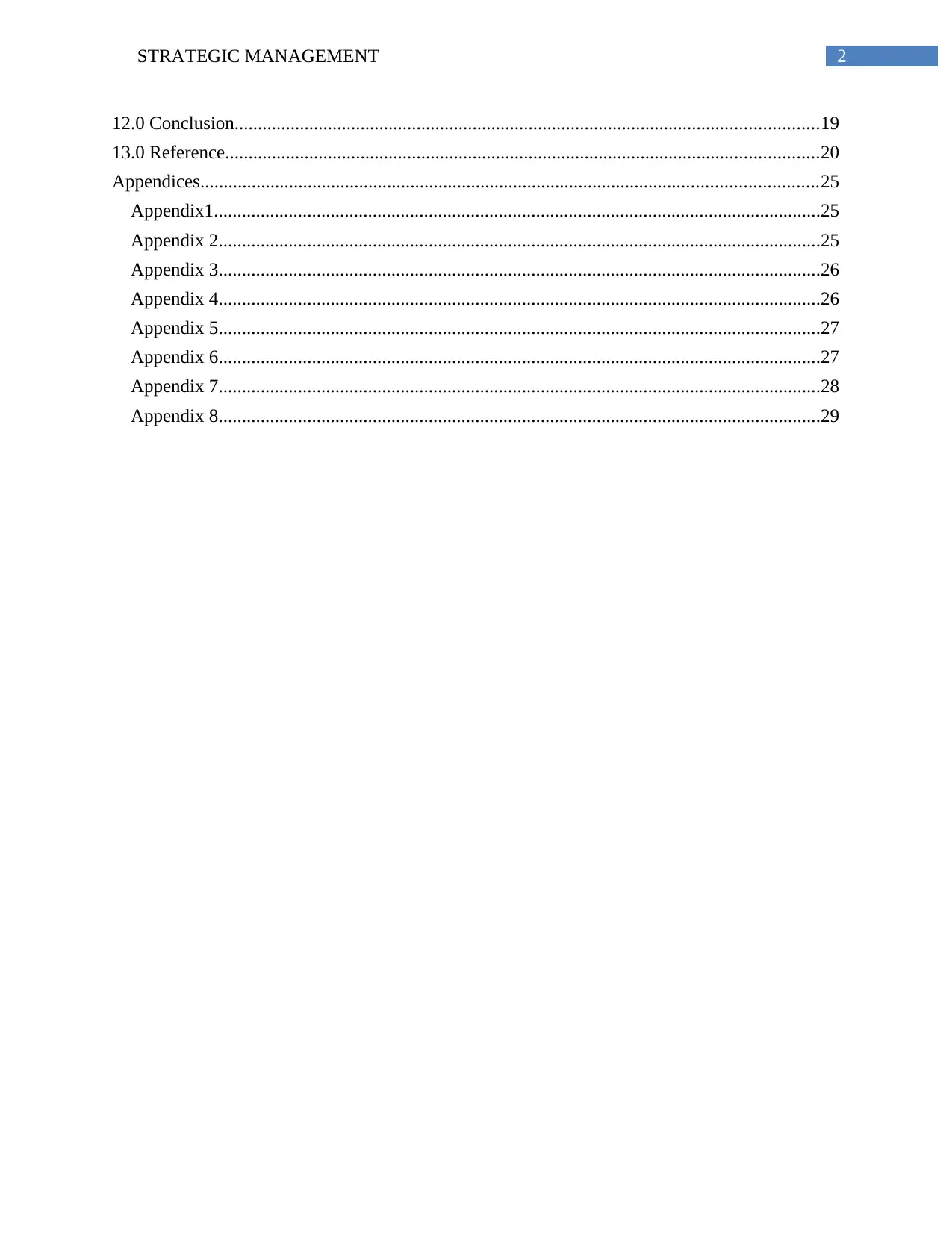
2STRATEGIC MANAGEMENT
12.0 Conclusion.............................................................................................................................19
13.0 Reference...............................................................................................................................20
Appendices....................................................................................................................................25
Appendix1..................................................................................................................................25
Appendix 2.................................................................................................................................25
Appendix 3.................................................................................................................................26
Appendix 4.................................................................................................................................26
Appendix 5.................................................................................................................................27
Appendix 6.................................................................................................................................27
Appendix 7.................................................................................................................................28
Appendix 8.................................................................................................................................29
12.0 Conclusion.............................................................................................................................19
13.0 Reference...............................................................................................................................20
Appendices....................................................................................................................................25
Appendix1..................................................................................................................................25
Appendix 2.................................................................................................................................25
Appendix 3.................................................................................................................................26
Appendix 4.................................................................................................................................26
Appendix 5.................................................................................................................................27
Appendix 6.................................................................................................................................27
Appendix 7.................................................................................................................................28
Appendix 8.................................................................................................................................29
⊘ This is a preview!⊘
Do you want full access?
Subscribe today to unlock all pages.

Trusted by 1+ million students worldwide
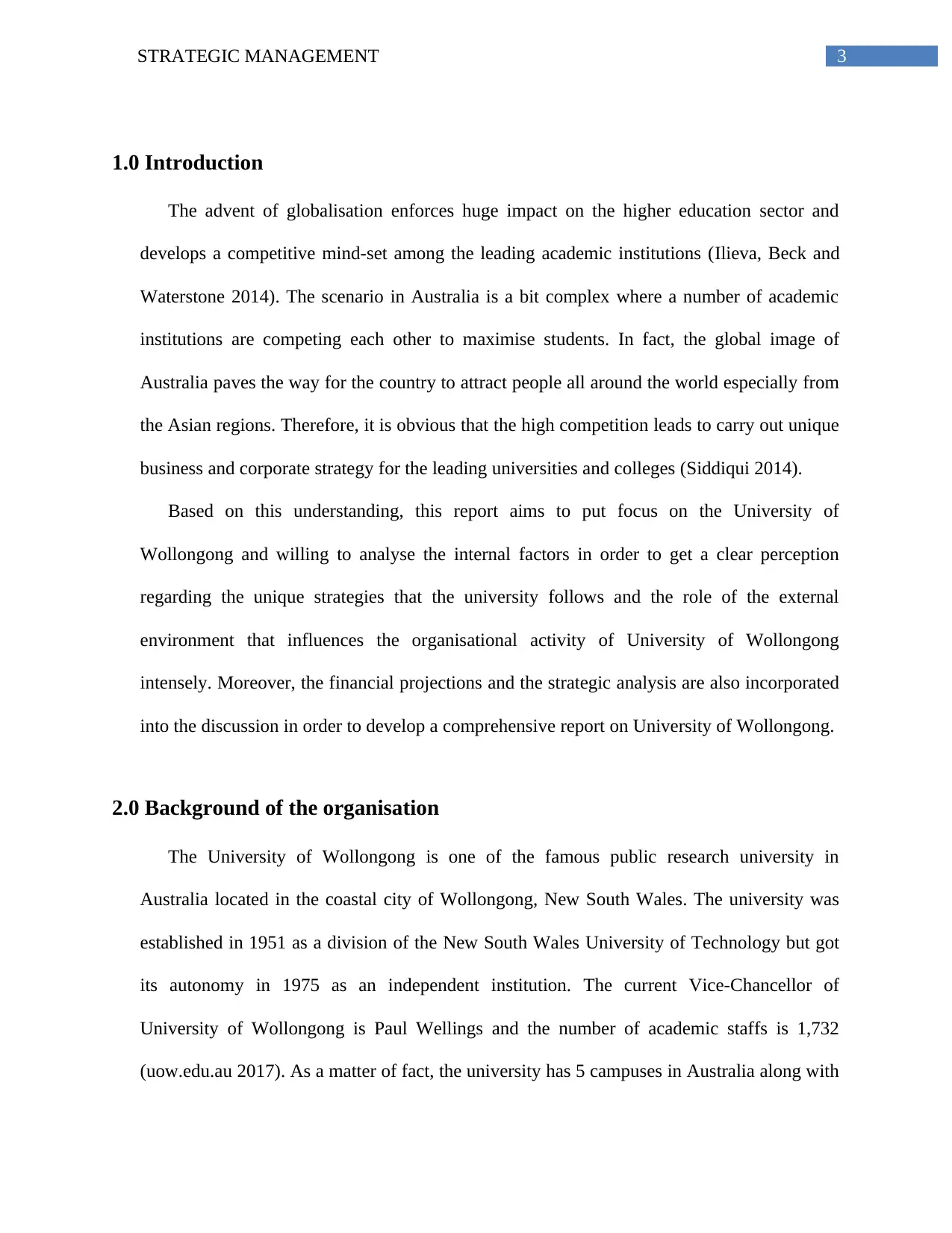
3STRATEGIC MANAGEMENT
1.0 Introduction
The advent of globalisation enforces huge impact on the higher education sector and
develops a competitive mind-set among the leading academic institutions (Ilieva, Beck and
Waterstone 2014). The scenario in Australia is a bit complex where a number of academic
institutions are competing each other to maximise students. In fact, the global image of
Australia paves the way for the country to attract people all around the world especially from
the Asian regions. Therefore, it is obvious that the high competition leads to carry out unique
business and corporate strategy for the leading universities and colleges (Siddiqui 2014).
Based on this understanding, this report aims to put focus on the University of
Wollongong and willing to analyse the internal factors in order to get a clear perception
regarding the unique strategies that the university follows and the role of the external
environment that influences the organisational activity of University of Wollongong
intensely. Moreover, the financial projections and the strategic analysis are also incorporated
into the discussion in order to develop a comprehensive report on University of Wollongong.
2.0 Background of the organisation
The University of Wollongong is one of the famous public research university in
Australia located in the coastal city of Wollongong, New South Wales. The university was
established in 1951 as a division of the New South Wales University of Technology but got
its autonomy in 1975 as an independent institution. The current Vice-Chancellor of
University of Wollongong is Paul Wellings and the number of academic staffs is 1,732
(uow.edu.au 2017). As a matter of fact, the university has 5 campuses in Australia along with
1.0 Introduction
The advent of globalisation enforces huge impact on the higher education sector and
develops a competitive mind-set among the leading academic institutions (Ilieva, Beck and
Waterstone 2014). The scenario in Australia is a bit complex where a number of academic
institutions are competing each other to maximise students. In fact, the global image of
Australia paves the way for the country to attract people all around the world especially from
the Asian regions. Therefore, it is obvious that the high competition leads to carry out unique
business and corporate strategy for the leading universities and colleges (Siddiqui 2014).
Based on this understanding, this report aims to put focus on the University of
Wollongong and willing to analyse the internal factors in order to get a clear perception
regarding the unique strategies that the university follows and the role of the external
environment that influences the organisational activity of University of Wollongong
intensely. Moreover, the financial projections and the strategic analysis are also incorporated
into the discussion in order to develop a comprehensive report on University of Wollongong.
2.0 Background of the organisation
The University of Wollongong is one of the famous public research university in
Australia located in the coastal city of Wollongong, New South Wales. The university was
established in 1951 as a division of the New South Wales University of Technology but got
its autonomy in 1975 as an independent institution. The current Vice-Chancellor of
University of Wollongong is Paul Wellings and the number of academic staffs is 1,732
(uow.edu.au 2017). As a matter of fact, the university has 5 campuses in Australia along with
Paraphrase This Document
Need a fresh take? Get an instant paraphrase of this document with our AI Paraphraser
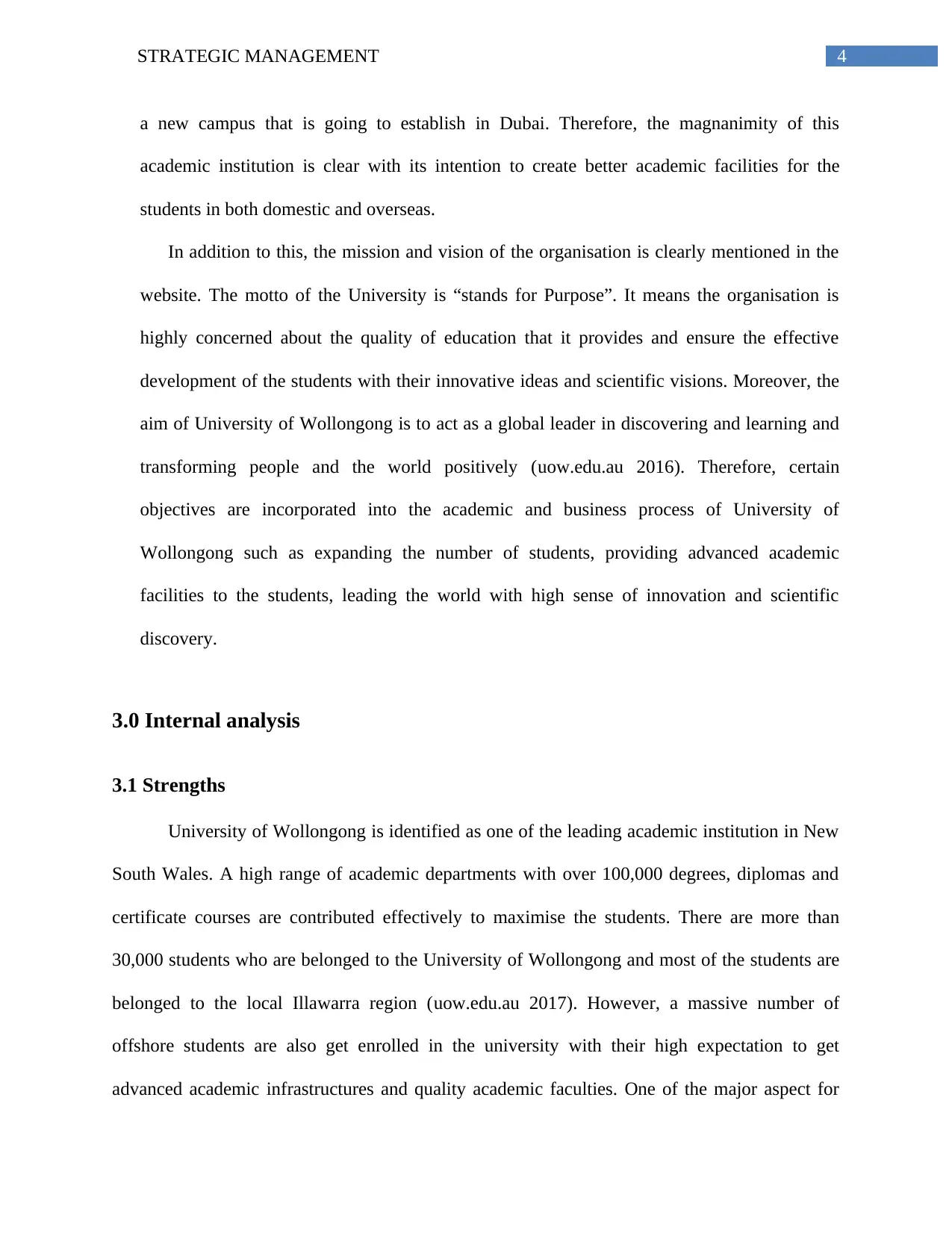
4STRATEGIC MANAGEMENT
a new campus that is going to establish in Dubai. Therefore, the magnanimity of this
academic institution is clear with its intention to create better academic facilities for the
students in both domestic and overseas.
In addition to this, the mission and vision of the organisation is clearly mentioned in the
website. The motto of the University is “stands for Purpose”. It means the organisation is
highly concerned about the quality of education that it provides and ensure the effective
development of the students with their innovative ideas and scientific visions. Moreover, the
aim of University of Wollongong is to act as a global leader in discovering and learning and
transforming people and the world positively (uow.edu.au 2016). Therefore, certain
objectives are incorporated into the academic and business process of University of
Wollongong such as expanding the number of students, providing advanced academic
facilities to the students, leading the world with high sense of innovation and scientific
discovery.
3.0 Internal analysis
3.1 Strengths
University of Wollongong is identified as one of the leading academic institution in New
South Wales. A high range of academic departments with over 100,000 degrees, diplomas and
certificate courses are contributed effectively to maximise the students. There are more than
30,000 students who are belonged to the University of Wollongong and most of the students are
belonged to the local Illawarra region (uow.edu.au 2017). However, a massive number of
offshore students are also get enrolled in the university with their high expectation to get
advanced academic infrastructures and quality academic faculties. One of the major aspect for
a new campus that is going to establish in Dubai. Therefore, the magnanimity of this
academic institution is clear with its intention to create better academic facilities for the
students in both domestic and overseas.
In addition to this, the mission and vision of the organisation is clearly mentioned in the
website. The motto of the University is “stands for Purpose”. It means the organisation is
highly concerned about the quality of education that it provides and ensure the effective
development of the students with their innovative ideas and scientific visions. Moreover, the
aim of University of Wollongong is to act as a global leader in discovering and learning and
transforming people and the world positively (uow.edu.au 2016). Therefore, certain
objectives are incorporated into the academic and business process of University of
Wollongong such as expanding the number of students, providing advanced academic
facilities to the students, leading the world with high sense of innovation and scientific
discovery.
3.0 Internal analysis
3.1 Strengths
University of Wollongong is identified as one of the leading academic institution in New
South Wales. A high range of academic departments with over 100,000 degrees, diplomas and
certificate courses are contributed effectively to maximise the students. There are more than
30,000 students who are belonged to the University of Wollongong and most of the students are
belonged to the local Illawarra region (uow.edu.au 2017). However, a massive number of
offshore students are also get enrolled in the university with their high expectation to get
advanced academic infrastructures and quality academic faculties. One of the major aspect for
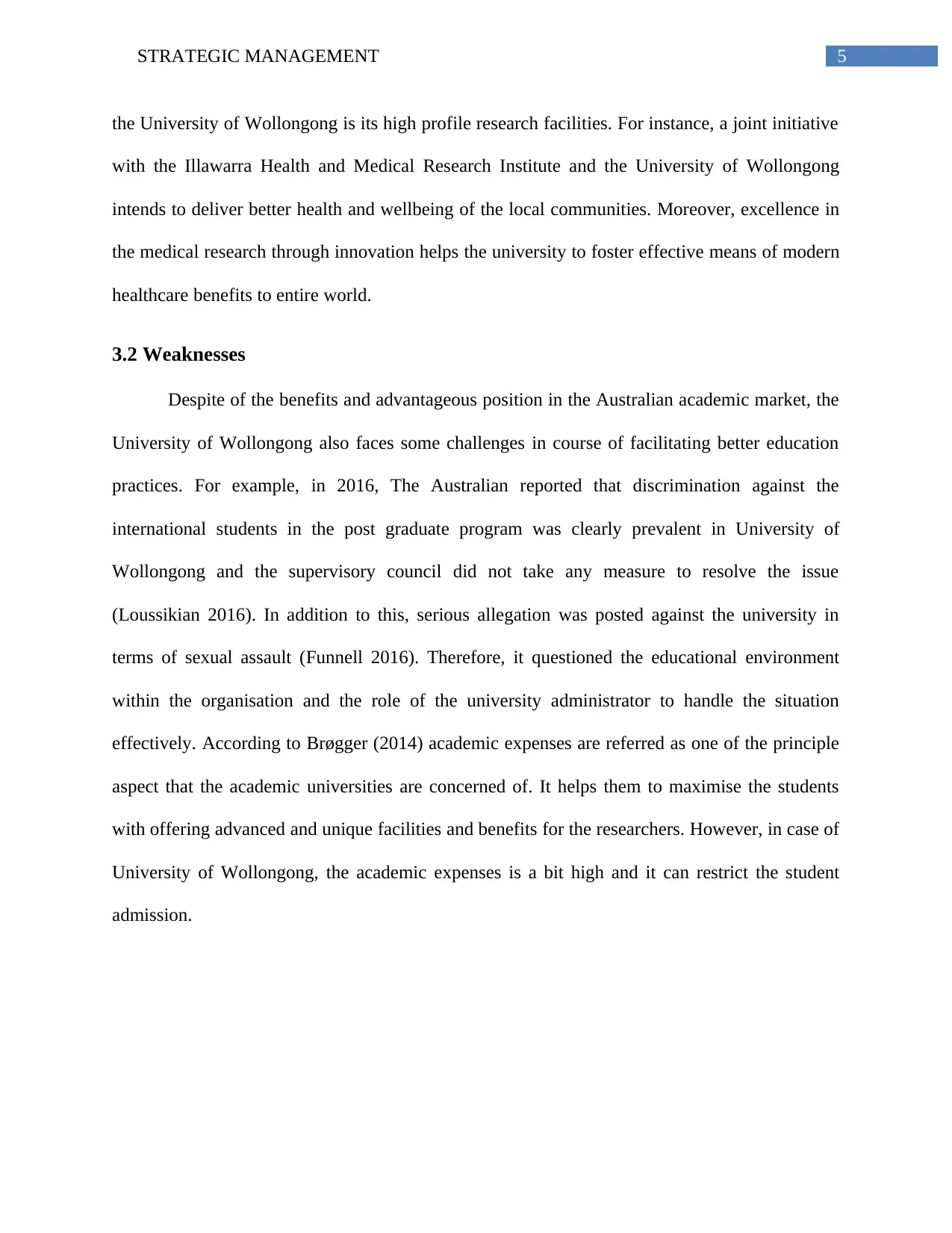
5STRATEGIC MANAGEMENT
the University of Wollongong is its high profile research facilities. For instance, a joint initiative
with the Illawarra Health and Medical Research Institute and the University of Wollongong
intends to deliver better health and wellbeing of the local communities. Moreover, excellence in
the medical research through innovation helps the university to foster effective means of modern
healthcare benefits to entire world.
3.2 Weaknesses
Despite of the benefits and advantageous position in the Australian academic market, the
University of Wollongong also faces some challenges in course of facilitating better education
practices. For example, in 2016, The Australian reported that discrimination against the
international students in the post graduate program was clearly prevalent in University of
Wollongong and the supervisory council did not take any measure to resolve the issue
(Loussikian 2016). In addition to this, serious allegation was posted against the university in
terms of sexual assault (Funnell 2016). Therefore, it questioned the educational environment
within the organisation and the role of the university administrator to handle the situation
effectively. According to Brøgger (2014) academic expenses are referred as one of the principle
aspect that the academic universities are concerned of. It helps them to maximise the students
with offering advanced and unique facilities and benefits for the researchers. However, in case of
University of Wollongong, the academic expenses is a bit high and it can restrict the student
admission.
the University of Wollongong is its high profile research facilities. For instance, a joint initiative
with the Illawarra Health and Medical Research Institute and the University of Wollongong
intends to deliver better health and wellbeing of the local communities. Moreover, excellence in
the medical research through innovation helps the university to foster effective means of modern
healthcare benefits to entire world.
3.2 Weaknesses
Despite of the benefits and advantageous position in the Australian academic market, the
University of Wollongong also faces some challenges in course of facilitating better education
practices. For example, in 2016, The Australian reported that discrimination against the
international students in the post graduate program was clearly prevalent in University of
Wollongong and the supervisory council did not take any measure to resolve the issue
(Loussikian 2016). In addition to this, serious allegation was posted against the university in
terms of sexual assault (Funnell 2016). Therefore, it questioned the educational environment
within the organisation and the role of the university administrator to handle the situation
effectively. According to Brøgger (2014) academic expenses are referred as one of the principle
aspect that the academic universities are concerned of. It helps them to maximise the students
with offering advanced and unique facilities and benefits for the researchers. However, in case of
University of Wollongong, the academic expenses is a bit high and it can restrict the student
admission.
⊘ This is a preview!⊘
Do you want full access?
Subscribe today to unlock all pages.

Trusted by 1+ million students worldwide
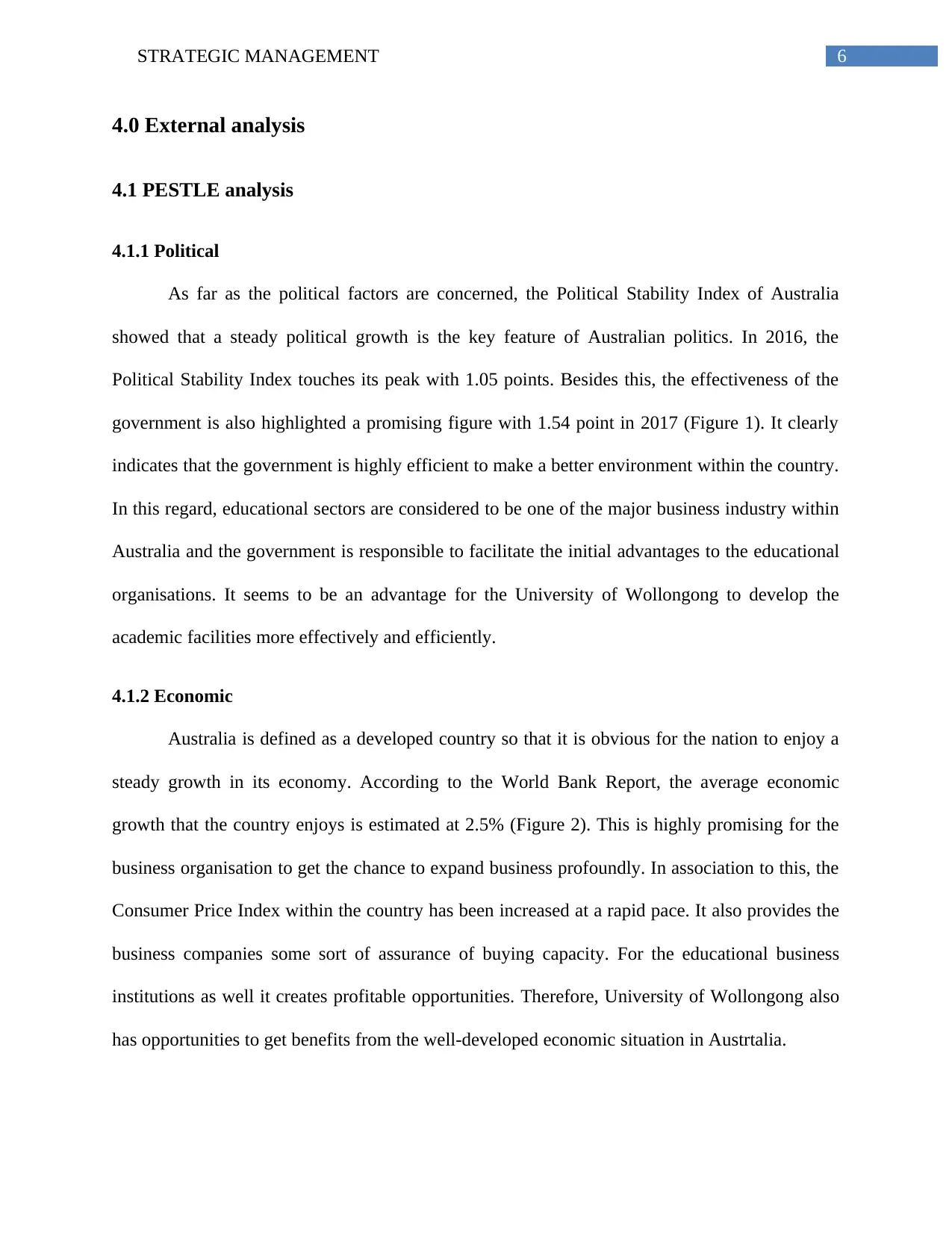
6STRATEGIC MANAGEMENT
4.0 External analysis
4.1 PESTLE analysis
4.1.1 Political
As far as the political factors are concerned, the Political Stability Index of Australia
showed that a steady political growth is the key feature of Australian politics. In 2016, the
Political Stability Index touches its peak with 1.05 points. Besides this, the effectiveness of the
government is also highlighted a promising figure with 1.54 point in 2017 (Figure 1). It clearly
indicates that the government is highly efficient to make a better environment within the country.
In this regard, educational sectors are considered to be one of the major business industry within
Australia and the government is responsible to facilitate the initial advantages to the educational
organisations. It seems to be an advantage for the University of Wollongong to develop the
academic facilities more effectively and efficiently.
4.1.2 Economic
Australia is defined as a developed country so that it is obvious for the nation to enjoy a
steady growth in its economy. According to the World Bank Report, the average economic
growth that the country enjoys is estimated at 2.5% (Figure 2). This is highly promising for the
business organisation to get the chance to expand business profoundly. In association to this, the
Consumer Price Index within the country has been increased at a rapid pace. It also provides the
business companies some sort of assurance of buying capacity. For the educational business
institutions as well it creates profitable opportunities. Therefore, University of Wollongong also
has opportunities to get benefits from the well-developed economic situation in Austrtalia.
4.0 External analysis
4.1 PESTLE analysis
4.1.1 Political
As far as the political factors are concerned, the Political Stability Index of Australia
showed that a steady political growth is the key feature of Australian politics. In 2016, the
Political Stability Index touches its peak with 1.05 points. Besides this, the effectiveness of the
government is also highlighted a promising figure with 1.54 point in 2017 (Figure 1). It clearly
indicates that the government is highly efficient to make a better environment within the country.
In this regard, educational sectors are considered to be one of the major business industry within
Australia and the government is responsible to facilitate the initial advantages to the educational
organisations. It seems to be an advantage for the University of Wollongong to develop the
academic facilities more effectively and efficiently.
4.1.2 Economic
Australia is defined as a developed country so that it is obvious for the nation to enjoy a
steady growth in its economy. According to the World Bank Report, the average economic
growth that the country enjoys is estimated at 2.5% (Figure 2). This is highly promising for the
business organisation to get the chance to expand business profoundly. In association to this, the
Consumer Price Index within the country has been increased at a rapid pace. It also provides the
business companies some sort of assurance of buying capacity. For the educational business
institutions as well it creates profitable opportunities. Therefore, University of Wollongong also
has opportunities to get benefits from the well-developed economic situation in Austrtalia.
Paraphrase This Document
Need a fresh take? Get an instant paraphrase of this document with our AI Paraphraser
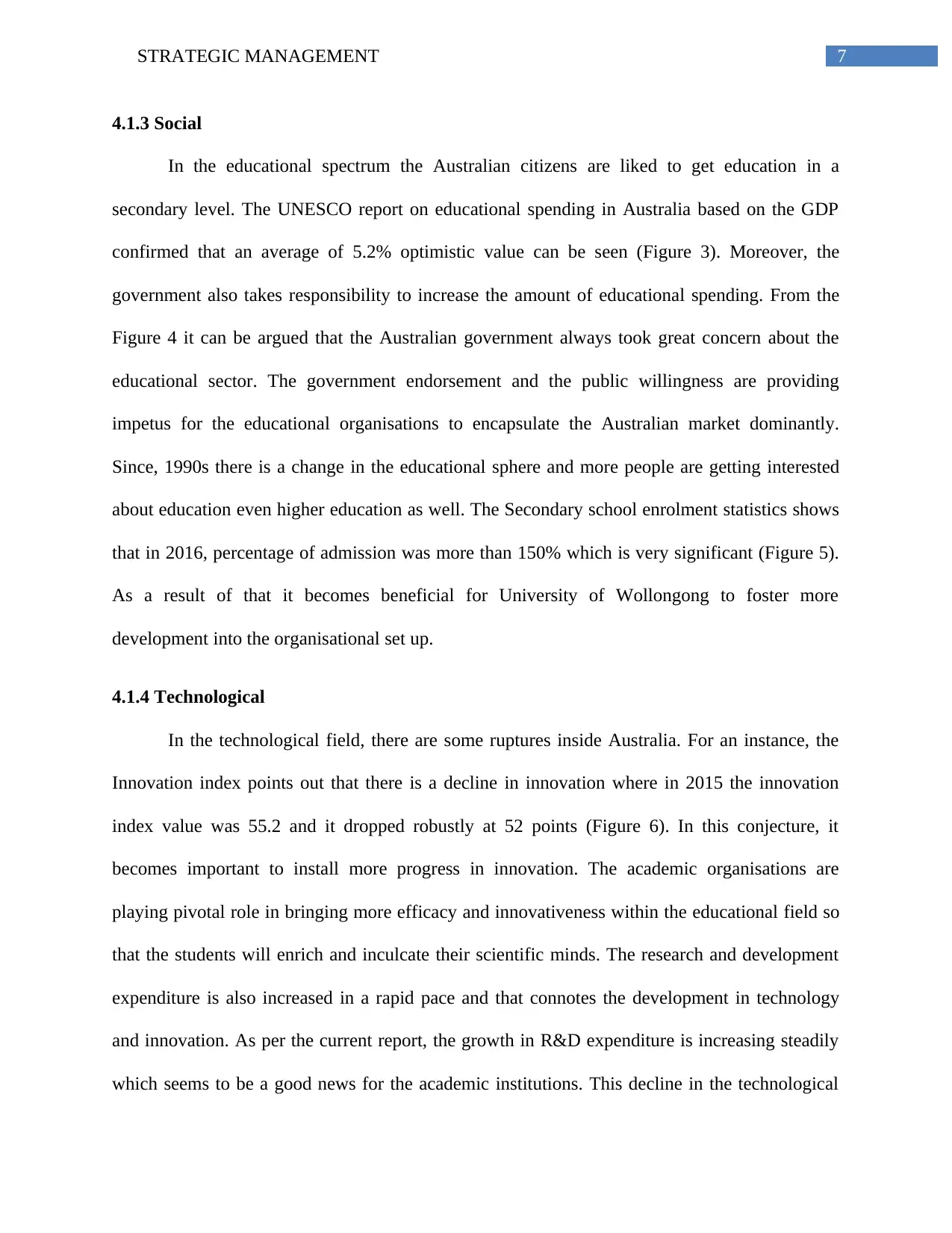
7STRATEGIC MANAGEMENT
4.1.3 Social
In the educational spectrum the Australian citizens are liked to get education in a
secondary level. The UNESCO report on educational spending in Australia based on the GDP
confirmed that an average of 5.2% optimistic value can be seen (Figure 3). Moreover, the
government also takes responsibility to increase the amount of educational spending. From the
Figure 4 it can be argued that the Australian government always took great concern about the
educational sector. The government endorsement and the public willingness are providing
impetus for the educational organisations to encapsulate the Australian market dominantly.
Since, 1990s there is a change in the educational sphere and more people are getting interested
about education even higher education as well. The Secondary school enrolment statistics shows
that in 2016, percentage of admission was more than 150% which is very significant (Figure 5).
As a result of that it becomes beneficial for University of Wollongong to foster more
development into the organisational set up.
4.1.4 Technological
In the technological field, there are some ruptures inside Australia. For an instance, the
Innovation index points out that there is a decline in innovation where in 2015 the innovation
index value was 55.2 and it dropped robustly at 52 points (Figure 6). In this conjecture, it
becomes important to install more progress in innovation. The academic organisations are
playing pivotal role in bringing more efficacy and innovativeness within the educational field so
that the students will enrich and inculcate their scientific minds. The research and development
expenditure is also increased in a rapid pace and that connotes the development in technology
and innovation. As per the current report, the growth in R&D expenditure is increasing steadily
which seems to be a good news for the academic institutions. This decline in the technological
4.1.3 Social
In the educational spectrum the Australian citizens are liked to get education in a
secondary level. The UNESCO report on educational spending in Australia based on the GDP
confirmed that an average of 5.2% optimistic value can be seen (Figure 3). Moreover, the
government also takes responsibility to increase the amount of educational spending. From the
Figure 4 it can be argued that the Australian government always took great concern about the
educational sector. The government endorsement and the public willingness are providing
impetus for the educational organisations to encapsulate the Australian market dominantly.
Since, 1990s there is a change in the educational sphere and more people are getting interested
about education even higher education as well. The Secondary school enrolment statistics shows
that in 2016, percentage of admission was more than 150% which is very significant (Figure 5).
As a result of that it becomes beneficial for University of Wollongong to foster more
development into the organisational set up.
4.1.4 Technological
In the technological field, there are some ruptures inside Australia. For an instance, the
Innovation index points out that there is a decline in innovation where in 2015 the innovation
index value was 55.2 and it dropped robustly at 52 points (Figure 6). In this conjecture, it
becomes important to install more progress in innovation. The academic organisations are
playing pivotal role in bringing more efficacy and innovativeness within the educational field so
that the students will enrich and inculcate their scientific minds. The research and development
expenditure is also increased in a rapid pace and that connotes the development in technology
and innovation. As per the current report, the growth in R&D expenditure is increasing steadily
which seems to be a good news for the academic institutions. This decline in the technological
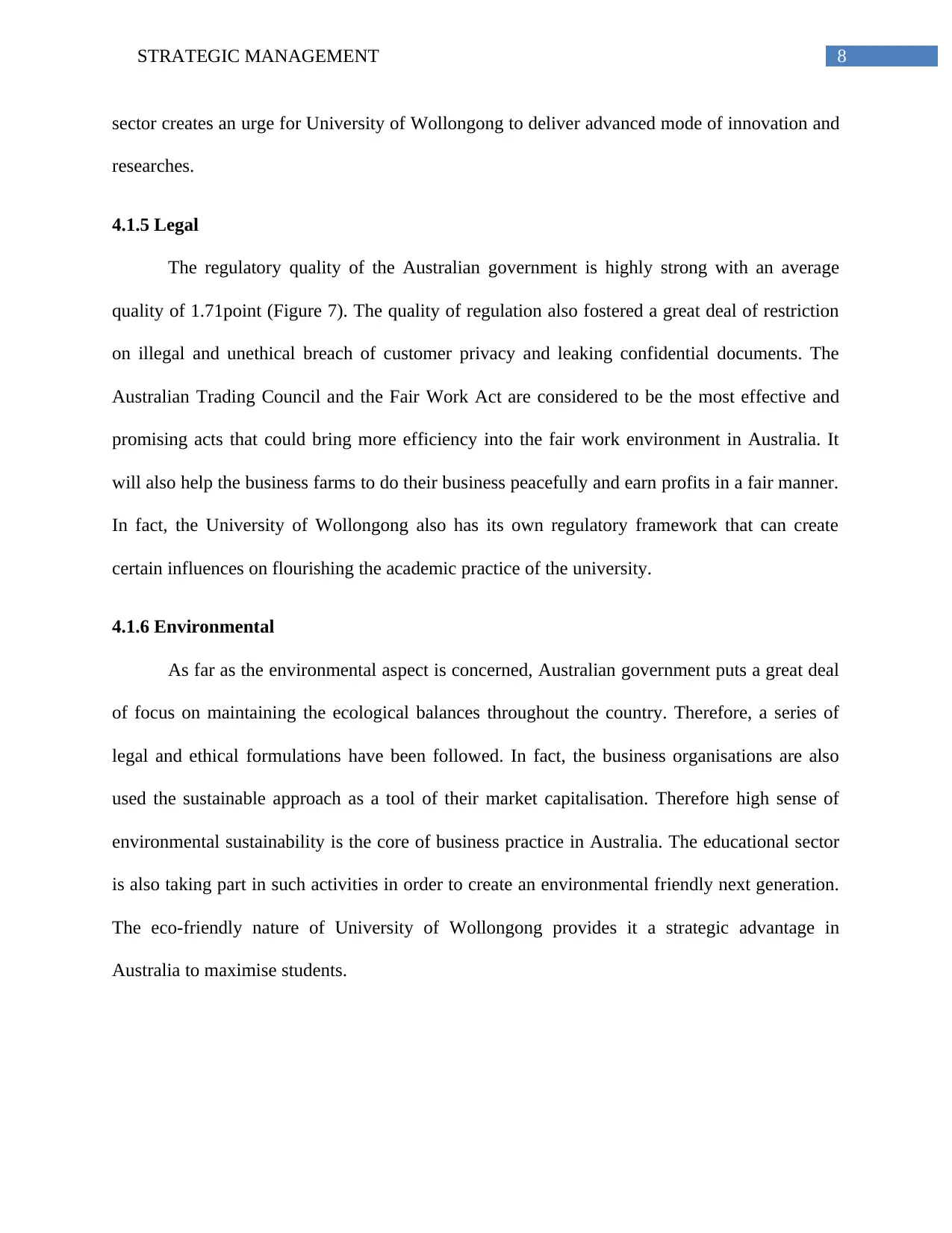
8STRATEGIC MANAGEMENT
sector creates an urge for University of Wollongong to deliver advanced mode of innovation and
researches.
4.1.5 Legal
The regulatory quality of the Australian government is highly strong with an average
quality of 1.71point (Figure 7). The quality of regulation also fostered a great deal of restriction
on illegal and unethical breach of customer privacy and leaking confidential documents. The
Australian Trading Council and the Fair Work Act are considered to be the most effective and
promising acts that could bring more efficiency into the fair work environment in Australia. It
will also help the business farms to do their business peacefully and earn profits in a fair manner.
In fact, the University of Wollongong also has its own regulatory framework that can create
certain influences on flourishing the academic practice of the university.
4.1.6 Environmental
As far as the environmental aspect is concerned, Australian government puts a great deal
of focus on maintaining the ecological balances throughout the country. Therefore, a series of
legal and ethical formulations have been followed. In fact, the business organisations are also
used the sustainable approach as a tool of their market capitalisation. Therefore high sense of
environmental sustainability is the core of business practice in Australia. The educational sector
is also taking part in such activities in order to create an environmental friendly next generation.
The eco-friendly nature of University of Wollongong provides it a strategic advantage in
Australia to maximise students.
sector creates an urge for University of Wollongong to deliver advanced mode of innovation and
researches.
4.1.5 Legal
The regulatory quality of the Australian government is highly strong with an average
quality of 1.71point (Figure 7). The quality of regulation also fostered a great deal of restriction
on illegal and unethical breach of customer privacy and leaking confidential documents. The
Australian Trading Council and the Fair Work Act are considered to be the most effective and
promising acts that could bring more efficiency into the fair work environment in Australia. It
will also help the business farms to do their business peacefully and earn profits in a fair manner.
In fact, the University of Wollongong also has its own regulatory framework that can create
certain influences on flourishing the academic practice of the university.
4.1.6 Environmental
As far as the environmental aspect is concerned, Australian government puts a great deal
of focus on maintaining the ecological balances throughout the country. Therefore, a series of
legal and ethical formulations have been followed. In fact, the business organisations are also
used the sustainable approach as a tool of their market capitalisation. Therefore high sense of
environmental sustainability is the core of business practice in Australia. The educational sector
is also taking part in such activities in order to create an environmental friendly next generation.
The eco-friendly nature of University of Wollongong provides it a strategic advantage in
Australia to maximise students.
⊘ This is a preview!⊘
Do you want full access?
Subscribe today to unlock all pages.

Trusted by 1+ million students worldwide
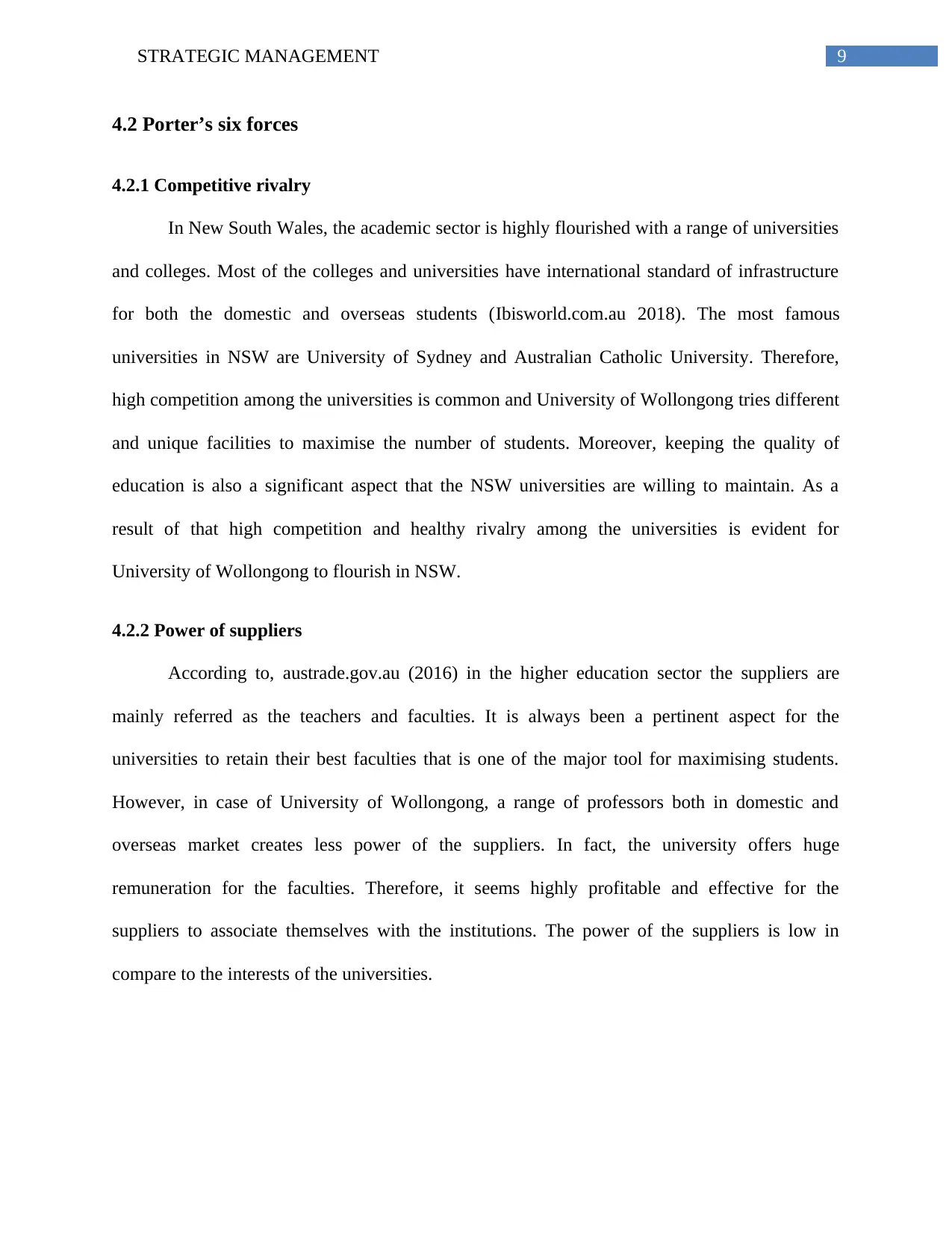
9STRATEGIC MANAGEMENT
4.2 Porter’s six forces
4.2.1 Competitive rivalry
In New South Wales, the academic sector is highly flourished with a range of universities
and colleges. Most of the colleges and universities have international standard of infrastructure
for both the domestic and overseas students (Ibisworld.com.au 2018). The most famous
universities in NSW are University of Sydney and Australian Catholic University. Therefore,
high competition among the universities is common and University of Wollongong tries different
and unique facilities to maximise the number of students. Moreover, keeping the quality of
education is also a significant aspect that the NSW universities are willing to maintain. As a
result of that high competition and healthy rivalry among the universities is evident for
University of Wollongong to flourish in NSW.
4.2.2 Power of suppliers
According to, austrade.gov.au (2016) in the higher education sector the suppliers are
mainly referred as the teachers and faculties. It is always been a pertinent aspect for the
universities to retain their best faculties that is one of the major tool for maximising students.
However, in case of University of Wollongong, a range of professors both in domestic and
overseas market creates less power of the suppliers. In fact, the university offers huge
remuneration for the faculties. Therefore, it seems highly profitable and effective for the
suppliers to associate themselves with the institutions. The power of the suppliers is low in
compare to the interests of the universities.
4.2 Porter’s six forces
4.2.1 Competitive rivalry
In New South Wales, the academic sector is highly flourished with a range of universities
and colleges. Most of the colleges and universities have international standard of infrastructure
for both the domestic and overseas students (Ibisworld.com.au 2018). The most famous
universities in NSW are University of Sydney and Australian Catholic University. Therefore,
high competition among the universities is common and University of Wollongong tries different
and unique facilities to maximise the number of students. Moreover, keeping the quality of
education is also a significant aspect that the NSW universities are willing to maintain. As a
result of that high competition and healthy rivalry among the universities is evident for
University of Wollongong to flourish in NSW.
4.2.2 Power of suppliers
According to, austrade.gov.au (2016) in the higher education sector the suppliers are
mainly referred as the teachers and faculties. It is always been a pertinent aspect for the
universities to retain their best faculties that is one of the major tool for maximising students.
However, in case of University of Wollongong, a range of professors both in domestic and
overseas market creates less power of the suppliers. In fact, the university offers huge
remuneration for the faculties. Therefore, it seems highly profitable and effective for the
suppliers to associate themselves with the institutions. The power of the suppliers is low in
compare to the interests of the universities.
Paraphrase This Document
Need a fresh take? Get an instant paraphrase of this document with our AI Paraphraser
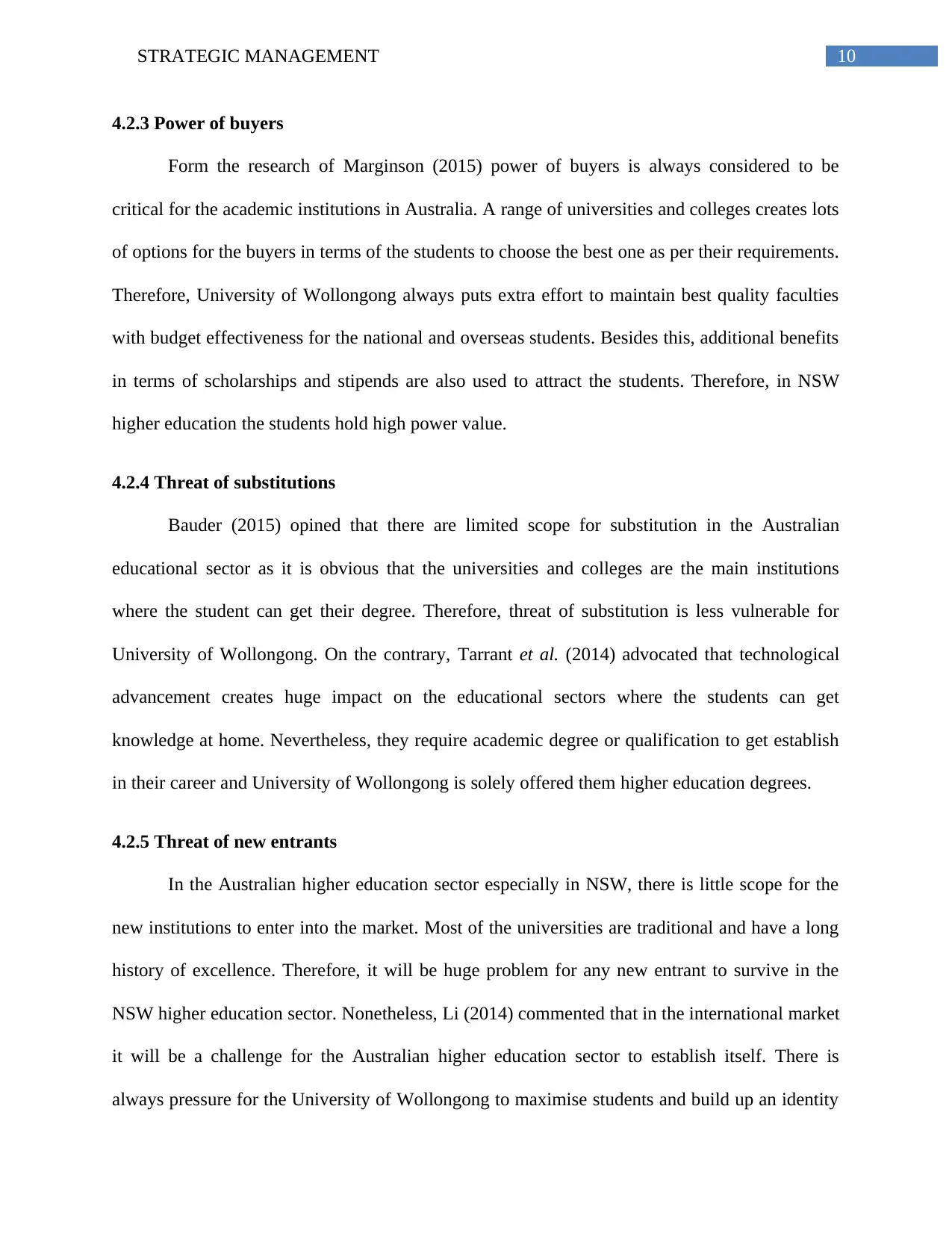
10STRATEGIC MANAGEMENT
4.2.3 Power of buyers
Form the research of Marginson (2015) power of buyers is always considered to be
critical for the academic institutions in Australia. A range of universities and colleges creates lots
of options for the buyers in terms of the students to choose the best one as per their requirements.
Therefore, University of Wollongong always puts extra effort to maintain best quality faculties
with budget effectiveness for the national and overseas students. Besides this, additional benefits
in terms of scholarships and stipends are also used to attract the students. Therefore, in NSW
higher education the students hold high power value.
4.2.4 Threat of substitutions
Bauder (2015) opined that there are limited scope for substitution in the Australian
educational sector as it is obvious that the universities and colleges are the main institutions
where the student can get their degree. Therefore, threat of substitution is less vulnerable for
University of Wollongong. On the contrary, Tarrant et al. (2014) advocated that technological
advancement creates huge impact on the educational sectors where the students can get
knowledge at home. Nevertheless, they require academic degree or qualification to get establish
in their career and University of Wollongong is solely offered them higher education degrees.
4.2.5 Threat of new entrants
In the Australian higher education sector especially in NSW, there is little scope for the
new institutions to enter into the market. Most of the universities are traditional and have a long
history of excellence. Therefore, it will be huge problem for any new entrant to survive in the
NSW higher education sector. Nonetheless, Li (2014) commented that in the international market
it will be a challenge for the Australian higher education sector to establish itself. There is
always pressure for the University of Wollongong to maximise students and build up an identity
4.2.3 Power of buyers
Form the research of Marginson (2015) power of buyers is always considered to be
critical for the academic institutions in Australia. A range of universities and colleges creates lots
of options for the buyers in terms of the students to choose the best one as per their requirements.
Therefore, University of Wollongong always puts extra effort to maintain best quality faculties
with budget effectiveness for the national and overseas students. Besides this, additional benefits
in terms of scholarships and stipends are also used to attract the students. Therefore, in NSW
higher education the students hold high power value.
4.2.4 Threat of substitutions
Bauder (2015) opined that there are limited scope for substitution in the Australian
educational sector as it is obvious that the universities and colleges are the main institutions
where the student can get their degree. Therefore, threat of substitution is less vulnerable for
University of Wollongong. On the contrary, Tarrant et al. (2014) advocated that technological
advancement creates huge impact on the educational sectors where the students can get
knowledge at home. Nevertheless, they require academic degree or qualification to get establish
in their career and University of Wollongong is solely offered them higher education degrees.
4.2.5 Threat of new entrants
In the Australian higher education sector especially in NSW, there is little scope for the
new institutions to enter into the market. Most of the universities are traditional and have a long
history of excellence. Therefore, it will be huge problem for any new entrant to survive in the
NSW higher education sector. Nonetheless, Li (2014) commented that in the international market
it will be a challenge for the Australian higher education sector to establish itself. There is
always pressure for the University of Wollongong to maximise students and build up an identity
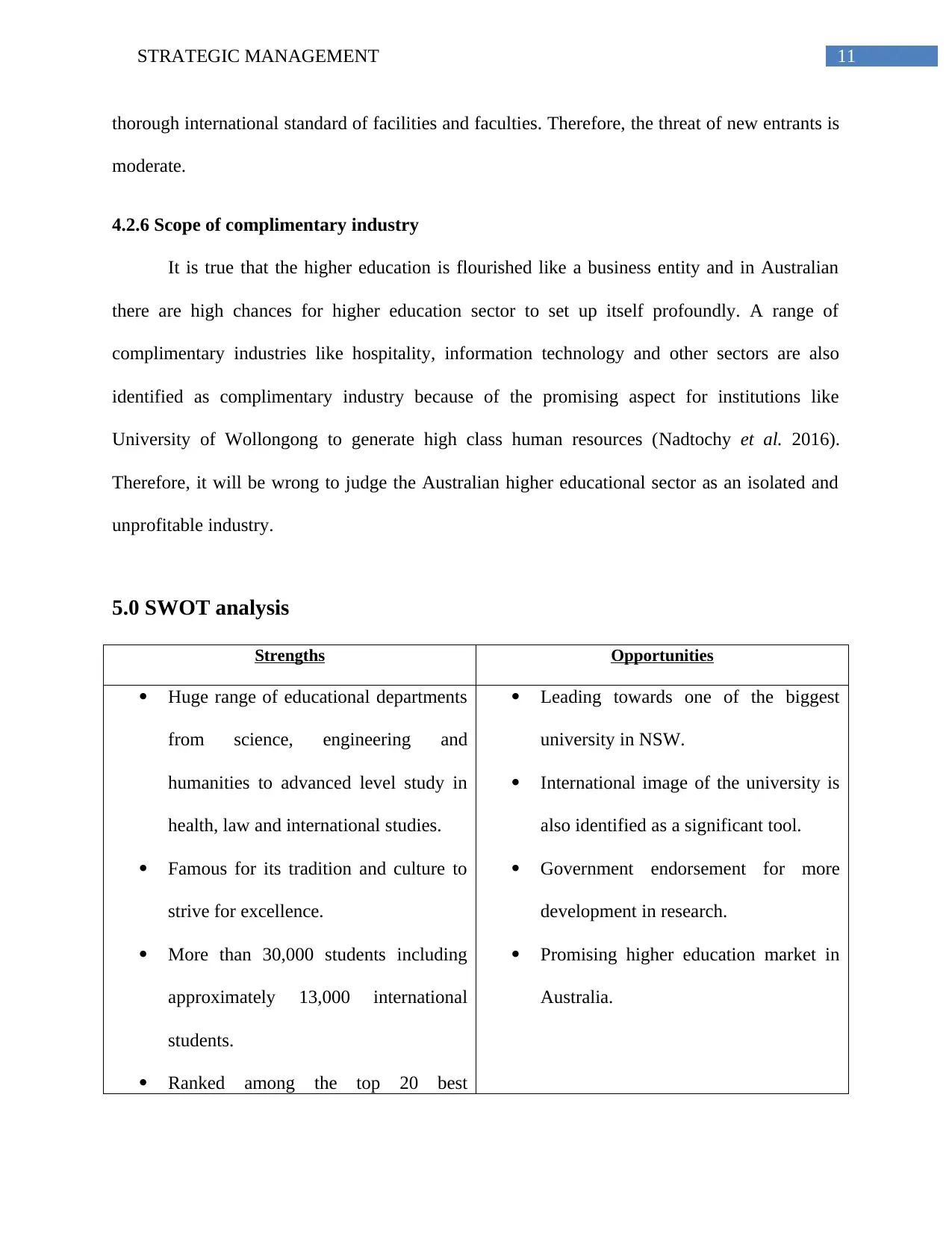
11STRATEGIC MANAGEMENT
thorough international standard of facilities and faculties. Therefore, the threat of new entrants is
moderate.
4.2.6 Scope of complimentary industry
It is true that the higher education is flourished like a business entity and in Australian
there are high chances for higher education sector to set up itself profoundly. A range of
complimentary industries like hospitality, information technology and other sectors are also
identified as complimentary industry because of the promising aspect for institutions like
University of Wollongong to generate high class human resources (Nadtochy et al. 2016).
Therefore, it will be wrong to judge the Australian higher educational sector as an isolated and
unprofitable industry.
5.0 SWOT analysis
Strengths Opportunities
Huge range of educational departments
from science, engineering and
humanities to advanced level study in
health, law and international studies.
Famous for its tradition and culture to
strive for excellence.
More than 30,000 students including
approximately 13,000 international
students.
Ranked among the top 20 best
Leading towards one of the biggest
university in NSW.
International image of the university is
also identified as a significant tool.
Government endorsement for more
development in research.
Promising higher education market in
Australia.
thorough international standard of facilities and faculties. Therefore, the threat of new entrants is
moderate.
4.2.6 Scope of complimentary industry
It is true that the higher education is flourished like a business entity and in Australian
there are high chances for higher education sector to set up itself profoundly. A range of
complimentary industries like hospitality, information technology and other sectors are also
identified as complimentary industry because of the promising aspect for institutions like
University of Wollongong to generate high class human resources (Nadtochy et al. 2016).
Therefore, it will be wrong to judge the Australian higher educational sector as an isolated and
unprofitable industry.
5.0 SWOT analysis
Strengths Opportunities
Huge range of educational departments
from science, engineering and
humanities to advanced level study in
health, law and international studies.
Famous for its tradition and culture to
strive for excellence.
More than 30,000 students including
approximately 13,000 international
students.
Ranked among the top 20 best
Leading towards one of the biggest
university in NSW.
International image of the university is
also identified as a significant tool.
Government endorsement for more
development in research.
Promising higher education market in
Australia.
⊘ This is a preview!⊘
Do you want full access?
Subscribe today to unlock all pages.

Trusted by 1+ million students worldwide
1 out of 30
Related Documents
Your All-in-One AI-Powered Toolkit for Academic Success.
+13062052269
info@desklib.com
Available 24*7 on WhatsApp / Email
![[object Object]](/_next/static/media/star-bottom.7253800d.svg)
Unlock your academic potential
Copyright © 2020–2025 A2Z Services. All Rights Reserved. Developed and managed by ZUCOL.





